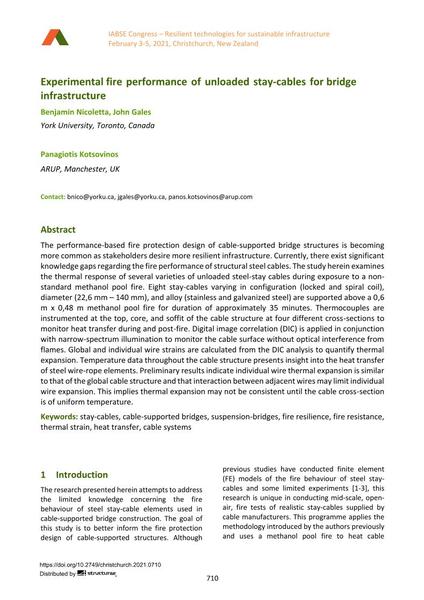Experimental fire performance of unloaded stay-cables for bridge infrastructure

|
|
|||||||||||
Bibliografische Angaben
| Autor(en): |
Benjamin Nicoletta
(York University, Toronto, Canada)
John Gales Panagiotis Kotsovinos |
||||
|---|---|---|---|---|---|
| Medium: | Tagungsbeitrag | ||||
| Sprache(n): | Englisch | ||||
| Tagung: | IABSE Congress: Resilient technologies for sustainable infrastructure, Christchurch, New Zealand, 3-5 February 2021 | ||||
| Veröffentlicht in: | IABSE Congress Christchurch 2020 | ||||
|
|||||
| Seite(n): | 710-716 | ||||
| Anzahl der Seiten (im PDF): | 7 | ||||
| DOI: | 10.2749/christchurch.2021.0710 | ||||
| Abstrakt: |
The performance-based fire protection design of cable-supported bridge structures is becoming more common as stakeholders desire more resilient infrastructure. Currently, there exist significant knowledge gaps regarding the fire performance of structural steel cables. The study herein examines the thermal response of several varieties of unloaded steel-stay cables during exposure to a non- standard methanol pool fire. Eight stay-cables varying in configuration (locked and spiral coil), diameter (22,6 mm – 140 mm), and alloy (stainless and galvanized steel) are supported above a 0,6 m x 0,48 m methanol pool fire for duration of approximately 35 minutes. Thermocouples are instrumented at the top, core, and soffit of the cable structure at four different cross-sections to monitor heat transfer during and post-fire. Digital image correlation (DIC) is applied in conjunction with narrow-spectrum illumination to monitor the cable surface without optical interference from flames. Global and individual wire strains are calculated from the DIC analysis to quantify thermal expansion. Temperature data throughout the cable structure presents insight into the heat transfer of steel wire-rope elements. Preliminary results indicate individual wire thermal expansion is similar to that of the global cable structure and that interaction between adjacent wires may limit individual wire expansion. This implies thermal expansion may not be consistent until the cable cross-section is of uniform temperature. |
||||
| Stichwörter: |
Wärmeübertragung Wärmeleitung Wärmetransfer Feuerwiderstand
|
||||
